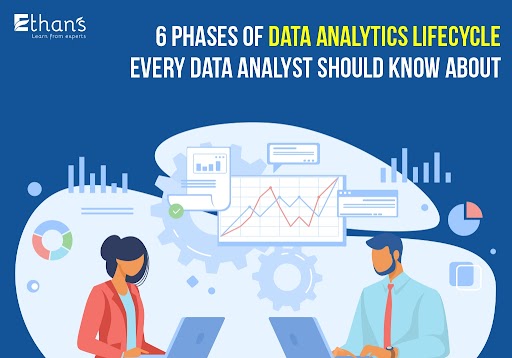Are you an aspiring data analyst looking to take up a data analytics course in Pune? Then, learning about the data analytics lifecycle is fundamental to your knowledge and expertise. So, let’s look at the data analytics lifecycle and the six phases, including discovery, data preparation, model planning, model building, communication results, and operationalization that make up for it.
Data Analytics Lifecycle and its Significance
The data analytics lifecycle defines the roadmap of the way data is generated, collected, processed, used, and analyzed to accomplish business goals. These processes refer to an organized way of converting data into useful information to help businesses achieve project or organizational goals. The lifecycle guides and provides strategies for extracting information and moving in the right direction to achieve business objectives.
Analysts use the circular representation of the lifecycle to analyze data in a forward or backward direction. The insights they receive help them decide whether to proceed with the existing research and stop or rework the analysis.
Why should you learn about the data analytics lifecycle? The lifecycle aims to address big data problems and data science projects. The systematic and step-by-step methodology helps analysts plan tasks concerning data acquisition, processing, analysis, and recycling. These phases or stages help data analysts address specific big data analysis needs.
6 Stages of Data Analytics Process
Before we see the phases of data analytics, let’s look at the various steps involved in data analysis with an example. Let’s say, an eCommerce portal is struggling with a massive number of cart abandonments. The decision-makers have taken cognizance of this concern and want to know what’s driving people away from the brand after creating a cart. As a data analyst, this is what you would do.
1. Define the Problem
The process begins with understanding the task and the stakeholder’s expectations for the solution. It would involve asking the managers and other stakeholders questions about cart abandonments to find a solution to their problem. It would also involve finding the problem’s root cause to understand the concern. A couple of key questions that you must ask yourself include;
- Which problems have the stakeholders mentioned
- What are their expectations from the solution
2. Data Collection
The next step is collecting data from multiple sources, including external and internal. Internal data is available in the company, whereas external information will have to be collected from outside the organization.
Data generated from own resources is first-party data, while that collected and sold is called second-party data. On the other hand, data collected from external sources is termed third-party data. Common sources of data are feedback, questionnaires, surveys, etc. Accordingly, as a data analyst, you will have to collect cart abandonment data from the system and conduct online surveys to ask users why did they abandon the cart.
3. Data Cleanup
The next process is cleaning the data collected. It might comprise redundancies, duplication, and irrelevant information. You must remove such data to ensure you have relevant and only the data you need to analyze. While helping you analyze the data effectively, it would also enable you to identify trends and patterns. Another significant part of this process is determining if the data is biased toward something. Such data wouldn’t let you drive the right inferences.
4. Data Analysis
This is where the actual analysis begins. It involves analyzing the data, identifying trends, making calculations (using tools like Excel or SQL (Structured Query Language), and combining data for better outcomes. Additionally, programming languages like R and Python also help you analyze data. In the context of the eCommerce company, it would involve understanding, analyzing, and grouping the various reasons for cart abandonments.
Check Out Full Blog – Data Preprocessing in Machine Learning: 7 Easy Steps to Follow
5. Data Visualization
Visualizing helps non-technical people or the consumers of the data understand complex data. The transformed data has to be made into a visual, including a chart or a graph for a simpler comprehension of the data. You can leverage various tools to do that. A couple of them include Tableau and Looker. Tableau includes a simple drag-and-drop tool that helps create effective visualizations. Whereas, Looker is a data viz tool directly connecting to the database and creating visualizations.
6. Data Presentation
Presentation is the last step in the data analysis process. It involves transforming raw information into an easily comprehensible and meaningful format. You can present the data in various forms, including graphs, charts, tables, etc., to make it easier for decision-makers to draw conclusions and make informed decisions.
For example, after analyzing the data, you’ve categorized various reasons for cart abandonments, including slowly loading web pages, external distractions, network issues, unspecified, etc. If you decide to show it through a pie chart, you will be able to show the reasons and their pie share depending on the cart cancellations they result in. If slowly loading the webpage is the most common reason, the company can make efforts to enhance the website’s speed and gradually reduce the number of canceled carts.
Data Analytics Lifecycle Phases
Here are the six phases that form the data analytics lifecycle.
Phase 1: Discovery
- The data science team explores the issue and investigates it.
- It builds context and understanding.
- Learn about the required and available data sources.
- The team builds an initial hypothesis that can later be tested with data.
Phase 2: Data Preparation
- Methods or steps to discover, preprocess, and condition data before modeling and analysis.
- An analytic sandbox is required. The team executes, loads, and transforms to get data into the sandbox.
- The team may perform data preparation tasks several times and not in a predefined order.
- Some tools used for this phase are Alpine Miner, Hadoop, and Open Refine.
Phase 3: Model Planning
- The data science team studies the data to identify connections between variables. Next, it selects crucial variables and the most useful models.
- Datasets used for testing, production, and training goals are created.
- The team builds and executes models depending on the work completed in the model planning phase.
- Tools used for this phase include STATSTICA and MATLAB.
Phase 4: Model Building
- The team members build datasets for training, testing, and production.
- It assesses whether the existing tools are adequate for running the models or the models if the models need an even more robust environment.
- Some examples of free tools include WEKA, Octave, and Rand PL/R.
- A couple of commercial tools include STATSTICA and MATLAB.
Phase 5: Result Communication
- The team must evaluate the model’s outcomes to establish the model’s success or failure criteria.
- It examines ways of showcasing their findings and results to stakeholders while considering assumptions and account warnings.
- Additionally, it should identify key findings, measure business value, and build a narrative to summarize and communicate the findings.
Phase 6: Operationalization
- The team conveys the project’s benefits more broadly.
- It establishes a pilot project to deploy work in a controlled way before expanding the project to the complete enterprise of users.
- The above enables developers to gain insights into performance and factors related to the model in a production environment at a small scale and then make the required adjustments before full deployment.
- The team provides final reports, codes, and briefings.
- Free or open-source tools include Octave, WEKA, MADlib, and SQL.
Example of Data Analytics Lifecycle – Manufacturing
Suppose a global manufacturing company has numerous vendors and sub-vendors serving its units across various geographies. It wants to optimize vendor contracts for increased cost savings. Once the data science team identifies the company’s goals, it finds the required data, prepares it, and takes it through the data analytics lifecycle.
The team observes various types of contractors. It suggests treating every contractor type uniquely. However, it doesn’t have information about it.
Here, the team should find data and create a hypothesis to see if the different contractor types impact the model outcomes. It must attempt to derive the right results. After doing so and being confident about the model results, it can deploy and integrate the model. It would help the team to identify vendors and sub-vendors per their contract prices, invoice value, inclusions, etc., and optimize contracts to fulfill their cost-saving objectives.
Conclusion
Data analytics is a complex and critical task involving various factors that make your role as a data analyst crucial for your employer or client. However, it isn’t as difficult as you may think. Of course, analyzing data demands an organized mindset and process, including understanding the above lifecycle phases. These phases involve vital steps that journey a company systematically to its objectives through reliable insights. Thus, you must study the data analytics lifecycle and practice extensively to master it.
Do you want to know how you can do that and become a qualified data analyst? Join Ethans. We offer comprehensive and competent data analytics courses in Pune that transform you into a data analyst every employer would want to hire! Call us at +91 95133 92223 for more details on our courses.




